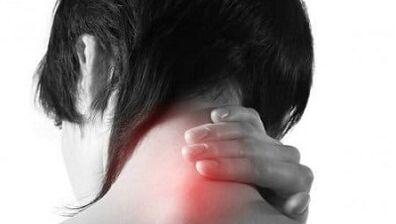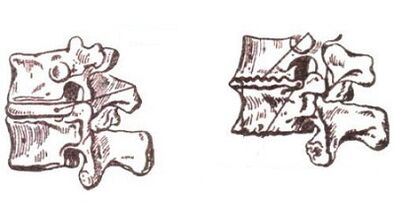
How to cure cervical spinal osteochondrosis and what is the cause of its appearance?This issue is concerned about women and men who have to solve problems with daily health problems: from annoying discomfort in the neck to severe headaches and other problems.
The main cause of the development of the disease is to reduce the distance between vertebrae due to the destruction of cartilage between them.
For reference.Osteochondrosis in the cervical spine is a degenerative-dystroph progressive disease, widely used due to excess vertebral movement in the neck.Spinal osteochondrosis causes uncontrolled physical activity, injury and poor muscle corset.All of these reasons eventually lead to the development of cervical osteochondrosis.
Etiology of the disease
The main reason why cervical osteochondrosis develops is to reduce the distance between vertebrae due to the gradual destruction of cartilage between them.Any unsuccessful position causes the transition of the vertebra, and the vessels and nerves are pinched.
The most common cause of development of osteochondrosis:
- Genetic predisposition of the disease.
- Excess weight and metabolic disorders.
- Frequent infections, body intoxication.
- Poor, lower nutrition with minimum intake of vitamins, trace elements and fluids, leading to vertebral deformation.
- Spinal curvature, injury, bruises, bone fractures, posture violations (Early departmental osteochondrosis).
- Flat feet and instability in the spinal segment, including the cervical vertebra body.
- Work related to weight lifting or frequent changes in body position (jerking, switching).
- Inactivity lifestyle, weak ecology.
- Doing hard work with the bone muscle system that has not been developed, leading to vertebral deformation.
- Long body position, overvoltage and nervous pressure.
- "Wrong" sleeping pillows that change the position of the cervical region vertebra.

Inactive lifestyle increases the risk of disease.
It is important to remember that the onset of osteochondrosis cannot be observed.That is why, with any unpleasant sensations in the neck, you should contact the specialist on time.
The following causes of osteochondrosis are theory, but are found in practice:
Involutionary
They are associated with trophic affected tissue during aging of the body, which is mainly on the intervertebral and vertebral discs, where a large number of blood vessels pass.
Hormone
Together with hormone disorders, dystrophic changes (osteochondrosis) occur in the body, which involves intervertebral discs in the process.
Vascular
They are observed if they violate segment circulation and water salt metabolism.Next, dystrophic changes are formed in tissues and organs, including neck osteochondrosis.
Contagious
Infections that occur in the intervertebral disc cervical spine and surrounding tissues interfere with the spread of lymph fluid and lead to changes in tissue and cervical vertebra in nutrition.This is what causes degenerative changes in the spine that exists in osteochondrosis.
Bioelectric
Bioelectric field vector power in the intervertebral disc occurs due to injury, load and temperature change.In the end, spinal osteochondrosis appears and is most often polysegent.
Mechanical
Significant injuries and advantages to the spine lead to violations of the integrity of the fibrous ring and the cervical spinal disc.
Anomaline
This refers to the congenital anomalies of the spinal column and the individual structure.At the same time, healthy vertebrae in the cervical region takes a double load, leading to the wear and development of their neck osteochondrosis.
Function
The main pathological changes are related to muscle tissue due to congenital or acquired factors.Uneven muscle contraction in one plane causes neck osteochondrosis.
Stage of disease
Cervical osteochondrosis has four degrees of disease.They are characterized by special symptoms and changes that affect the cervical region:

- At the first stagePulpos nucleus damage occurs as a result of infringement of the metabolic process.It becomes less elastic, dry and does not overcome the burden on the cervical spine.In the first stage, the patient does not feel the pain, only sometimes the stiffness occurs.Treatment at the level of damage to the cervical region is the most effective, the massage course is easy to help.
- In 2 degreesDamage to the fibrous ring occurs, the microckey forms on the sides and back of the vertebral disc.Patients with pathology at this stage begin to feel pain in the neck.
- In 3 degreesThe bone structure is changing, the fibrous ring is defective and torn.All nearby tissues, nerves and blood vessels suffer, lack of air, noise in the ear and head is felt by the patient.Neck osteochondrosis in 3 degrees is characterized by the appearance of pain in the back of the head, making the head very difficult.
- In 4 degreesThere is a degenerative recovery of the spine, the process lasts for a year.In defective vertebrae, changes in bone tissue growth occur (widely grow).The sore spine gradually turns into a non -static frozen bone column.
Only timely prevention of osteochondrosis will help prevent the development of the disease.
The main manifestations of osteochondrosis, including polyseggmentari, were found after 35 years, and older people, more often patients complained of experts in neck pain.The most common cause of pathology is when we live a long time on a computer and drive a car.The forced position of the spine leads to instability in the spinal column.
Clinical manifestations of characteristics
Symptoms of cervical osteochondrosis have a clear personality and different from the symptoms of other spinal disease manifestations.This is due to the features of the vertebral structure and the fact that they are closer than the thoracic and lumbar parts.That is why even with the smallest pathology, cervical osteochondrosis makes her feel faster.
The following signs of cervical spinal osteochondrosis are the most characteristic:
Sore
The first symptom that gives one to know about the onset of the neck problem.It can be localized: neck, back head, shoulders, hands.If the nerve spine is involved in the pathological process, which is "responsible" for the preservation of the upper arm, there is an unpleasant sensation that resembles heavy lifting.The pain in the back of the head occurs with severe spasms from the neck muscles that are affixed to the occipital bone.In addition, blood flow is disrupted, which causes the appearance of poor blood supply symptoms in the brain.
Disadvantages in hand

Such symptoms are caused by damage to the nerve roots and fibers that perform motor function and absorb the hand muscles.
Symptoms of the disease can be weak and weak in the hands.
Poor sensitivity in hand
These symptoms are explained by damage to sensitive nerve fibers that combine the skin.
Crowns and restrictions of neck mobility
These are the symptom symptoms that indicate the "drying" of the intervertebral disc.In addition, the growth of bone tissue occurs and degeneration of small joints located between the cervical vertebra.
Bad coordination
Symptoms indicate that cervical osteochondrosis lasts.The nerves and arteries of the vertebrae are squeezed, and when fibrous tissue is formed and the displacement of the vertebra, the blood flow worsen, leading to the occurrence of symptoms that indicate poor blood supply to the cerebellum and the brain.In severe cases, the following symptoms develop: hearing loss, numbness, vision problems.
As you can see, osteochondrosis is not necessarily a harmless disease, which is a fluent symptom talking about fluent.
The principle of therapeutic steps
Treatment of cervical osteochondrosis in men and women is based on stopping all symptoms of the disease and eliminating the cause of why cervical osteochondrosis develops.Symptoms are mainly associated with compression of nerve fibers and blood vessels, so it is important to eliminate edema, inflammation and restore normal blood supply.Early cervical osteochondrosis managed to retreat when physiotherapy training was involved, when the drug did not use the help.
The success of the treatment depends only on the work of a qualified doctor's team.
With the development of cervical osteochondrosis, a local therapist, who is almost always handled, helps a little.As a rule, the treatment is just a symptom, but it cannot fully know and eliminate the cause of the disease.Therefore, the success of treatment depends solely on the work of qualified doctors: vertebroneurologists, neurologists, surgeons, physiotherapists and massage therapists.

Treatment of osteochondrosis of the cervical area is important to start in the early stages, otherwise, in stage 2-3, strong changes in vertebrae occur and treatment will be long, difficult and not always effective.The basis for the treatment of neck problems is to take medicine, physiotherapy, massage and therapeutic training.
Preparation used for cervical osteochondrosis:
- NSAID.
- Vitamin preparations.
- Medications that increase blood flow.
- Musorelaxants.
- Chondroprotectors.
Cervical osteochondrosis treatment is performed using the following physiotherapy methods:
- Ultrasound (relieves pain, improves metabolic processes).
- Electrophoresis (drug transmission to problem area).
- Laser therapy (relieves inflammation and improves blood circulation).
- Magnetotherapy (relieves tissue edema).
Cervical osteochondrosis cannot be underestimated.Often in men and women there is little discomfort in the neck, especially by sitting on a computer or in another forced position.At first, you don't have to take medicines, but try to eliminate the cause or periodically do simple charging (at work or at home).Indications for surgical treatment: lack of conservative treatment (medication, physiotherapy, gymnastics), persistent pain, myelopathy, cerebral circulation disorders.






















